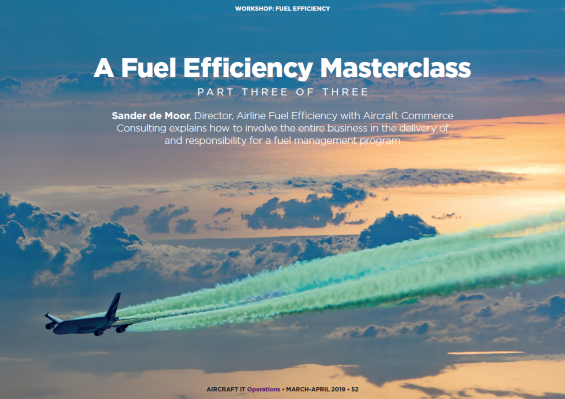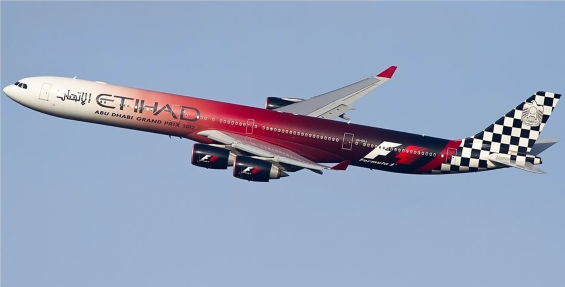Articles
| Name | Author | |
|---|---|---|
| Case Study: Finnair – Introducing an EFB-based operational efficiency tool to the Airbus A350 fleet | Henri Lönn, Development & Support Manager, Finnair | View article |
| A Fuel Efficiency Masterclass PART THREE OF THREE | Sander de Moor, Director, Airline Fuel Efficiency, Aircraft Commerce Consulting | View article |
| Going paperless at Cebu Pacific | Francesc Torres, Director - Operational Support at Cebu Pacific | View article |
| Building an EFB program on experience at airBaltic | View article |
A Fuel Efficiency Masterclass PART THREE OF THREE
Author: Sander de Moor, Director, Airline Fuel Efficiency, Aircraft Commerce Consulting
SubscribeA fuel Efficiency Masterclass Part 3

Sander de Moor, Director, Airline Fuel Efficiency with Aircraft Commerce Consulting explains how to involve the entire business in the delivery of and responsibility for a fuel management program
In the previous two parts of this masterclass, we tackled a range of issues that can have an impact on fuel efficiency in an airline or with an aircraft operator and we offered readers some practical ideas on where fuel savings might be found and realized.
At the beginning, I shared some thoughts from my own experience in the field on why fuel efficiency (or operational efficiency) management matters, including the fact that better-managed airlines also enjoy better informed safety processes. We considered how to go about starting a fuel efficiency program and, most importantly, if it’s to be managed, how to create and apply a fuel budget. Cost of weight was another area that we examined closely as well as using data to discover where fuel savings can be made, to design initiatives, and to monitor and manage those initiatives. Most of the above falls into the remit of Flight Operations but, if fuel efficiency is to succeed, it will require the positive involvement of many other departments, large and small. In this final part, we’re going to look at how other departments can assist in and share responsibility for a fuel management program, keeping in mind the ultimate goal of ‘planning and operating efficient aircraft efficiently’.
MAINTENANCE AND ENGINEERING
This is often not a primary area for fuel efficiency program targeting but clearly the airline will wish to make the airframe-engine combination as efficient as possible: so there are a number of areas in which Maintenance and Engineering can contribute to fuel efficiency. The skin of an aircraft should be clean with no warps, dents, doublers or triplers, no peeling paint, no leaking hydraulics all over the aircraft… in fact, as few flaws as possible to help ensure that the airflow boundary layer remains intact as long as possible, creating minimal disruptions to the laminar flow around the surfaces. Everything should be done that needs to be done to make the aircraft aerodynamically perfect; and that goes for the systems and the engines as well. In fact, a lot of work needs to be done with the engines such as engine washing as frequently as financially reasonable. As an example from when I was working with Etihad, an intensified engine washing program was started with their A340s at every ‘A’ check, every six to eight weeks, as a result of which the fuel use dropped by 2%. Now, 2% on an A340 is a lot of fuel at the end of the year, so it was definitely worth the effort.
There are a number of areas of interest as far as the physical condition of the aircraft is concerned:
- Maintenance Planning Documents (MPD):
- Strict adherence vs. Efficiency-driven tasking;
- Bundling of tasks;
- Regular revision of contracts.
- Airframe:
- The effect of any changes that cause weight increase;
- Dirt on the aircraft causing aerodynamic drag and added weight;
- Aerodynamic degradation (see ‘clean skin’, above);
- Deformation;
- Rigging;
- Avionics calibration;
- Bleed air systems, leakage at couplings.
- Engines:
- Contamination of Blades (any blades!);
- Wear & Tear; Blade rubbing;
- Specific Fuel Consumption (SFC);
- Overhaul vs. Degraded performance;
- Regular revision of contracts.
- Systems:
- Loss of Efficiency over time;
- Leaks;
- Sensors;
- Calibration.
- General:
- Fleet age effects;
- Contribution of modifications to fuel efficiency.
There are also a number of topics to discuss with colleagues:
- Current fuel conservation initiatives;
- Maintenance program and Tasks Cards;
- Aircraft performance monitoring;
- Engine / Auxiliary Power Unit (APU);
- Aircraft cleanliness, drag and weight;
- Modifications made to and proposed for the aircraft;
- Fuel management awareness training.
The Maintenance and Engineering vision should be to move beyond airworthiness alone and towards enabled and supported, optimized efficiency.
GROUND OPERATIONS
This is another department whose efforts can make a difference to fuel efficiency. Areas of interest and for discussions include aircraft handling management, load planning management, weight and balance… all with a view to making sure that the aircraft is loaded as optimally as possible.
- Aircraft Handling: so that the aircraft burns the least possible fuel in flight:
- Electrical Power and Cabin Conditioning – APU, GPU (Ground Power Unit), PCA (Pre-conditioned Air). Importantly with the APU are the GPU and PCA. In most stations, the fuel burn of the APU is not part of the station budget, which is more driven by how much they pay for the ground handling contract, but the station manager or the airport manager like to run the APU because they then don’t have to pay for the GPU contract; they look good but the fuel budget is growing because the APU is running unnecessarily and APU costs are actually quite high. So an idea would be to make stations responsible for the overall cost of the turn including the APU unit and its fuel burn, etc. That might, quite quickly, have everybody switching to GPU, where possible.
- Aircraft Movement –Taxi, GSE (Ground Services Equipment), de-icing.
- Ground Handling Optimization – fuel, turn-time, aircraft servicing – weight impact.
- Aircraft – fuelling, potable water, lavatory, cleaning – reduce the weight if possible and there are programs available to do that.
- Zero Fuel Weight Accuracy and Center of Gravity (CofG) Management:
- EZFW vs. AZFW; Management & Mitigation
- CofG planning; Procedures and Tracking.
COMMERCIAL AREAS
And those people in the commercial departments of the airline cannot escape their part in this fuel management effort; after all, what they propose will often affect weight. We want lighter aircraft: but how much do readers think a paint scheme like that in figure 8 costs, apart from the time and cost for putting it on?

Figure 8
It’s a lovely paint scheme, true; but there are already hundreds of kilos of weight on this aircraft for no reason other than branding and, to carry it around for the five years that this scheme was on the aircraft will have cost a lot of money. If the marketing budget is that big and they have the money available, great; but make sure that marketing then contribute to the fuel budget for the extra fuel required to carry their livery around. As well as fuel, it increases the maintenance cost because the airline has to make sure that the paint scheme stays beautiful, otherwise the brand image will suffer. Also, for the fuel efficiency group, it’s very important that the next time the airline chooses a new first-class seat, you have input to that because you don’t want that seat to weigh a hundred kilos: it costs fuel to carry that seat around all the time whether or not there’s a fare paying passenger sitting in it. The same for cabin equipment, catering and all of that… once you dive into fuel efficiency you’ll need to be aware of the impact of all of that.
There are also the fleet-specific issues of fleet planning, network planning and equipment as well as the aircraft-specific matters such as:
- Cabin equipment weight (galleys, equipment, trolleys, etc.);
- Cabin configuration (seats, carpets, toilets, dividers, trolleys, etc.);
- Catering (dishes, cutlery, napkins, weight of meals, selections, etc.);
- Amenities (magazines, newspapers, pillows, blankets, toiletries, gear, etc.);
- Duty Free (offered goods, magazine vs. IFE (In-Flight Entertainment), weight vs. sales, tracking inventory, etc.).
When you start to think about it, there are a host of matters that are the responsibilities of people across the airline that might have a bearing on weight, efficiency and fuel use. Etihad’s 787s weight 5 tons more than other operators. And that’s only the MEW (Manufacturers Empty Weight), not the DOW (Dry Operating Weight)! A Weight Committee could maybe have prevented this.
CHOOSING THE RIGHT FUEL EFFICIENCY SOFTWARE AND GETTING THE MOST FROM THE CURRENT SOLUTION
This is a very important step and I can’t over-stress this. Data is taken from the flight scheduling system, flight planning system, FOQA (Flight Operations Quality Assurance) system, and others such as Weight & Balance and DCS (Data Coding Scheme); and that data is checked and cleaned before it is presented to the fuel efficiency software (figure 9).

Figure 9
That software has the analysis tools and the communication tools. Figure 9 shows a general flow of how this information is being processed by such a system and how the Fuel Efficiency Team can use it. Now, vendors will explain a lot of detail about this but the diagram shows basically how it works. Back in the day we used to do all of this ourselves using Excel or similar, which was no fun and took forever; today we have the proper tools to create analyses on a click and communicate it all throughout the company basis. With web-access there’s no longer any hiding from the truth in the data.
IN SUMMARY
So, in closing, if you work for an airline that does not have a fully developed, current and embedded fuel efficiency program, you will be wasting millions of dollars. I say this again- millions of dollars. There is so much potential to save fuel even in some of the ‘optimized’ airlines. At Aircraft Commerce Consulting we have first-hand knowledge of these subjects, and bring it all to you during our intense Fuel Efficiency Health Check service; over a couple of days’ visit we provide an analysis of an airline’s efficiency today, following which we offer some recommendations of what could be done better and what could be changed in the airline to reach a higher state of efficiency. We can even help with setting up a complete program.
Contributor’s Details
 Sander de Moor
Sander de MoorSander de Moor has more than 30 years’ experience in flight operations support across all sectors of aviation with particular expertise in Flight Operations Efficiency, specializing in fuel and operational efficiency strategies. He was a member of the IATA Green Teams for two years and subsequently he has held the position of Fuel Efficiency lead at LOT Polish Airlines and Etihad Airways. Sander has extensive experience in managing RFP and implementation processes with FMIS (Fuel management Information Systems) tools across group airlines. .
 Aircraft Commerce Consulting
Aircraft Commerce ConsultingAircraft Commerce and Aircraft IT have joined forces with a group of best-in-class consultants to form ‘Aircraft Commerce Consulting’. This uniquely-capable and experienced team now stands ready to work with airlines and aircraft operators in developing strategies to unlock and enhance the full potential of both aircraft operations and associated IT systems. Key Services Include: Fuel Efficiency, EFB, Crew Planning , IT Systems Health-Checks for MRO / M&E Systems and more.
Comments (0)
There are currently no comments about this article.

To post a comment, please login or subscribe.